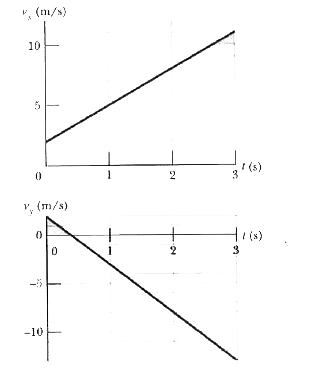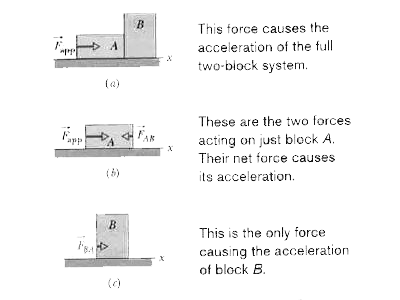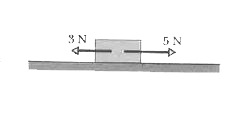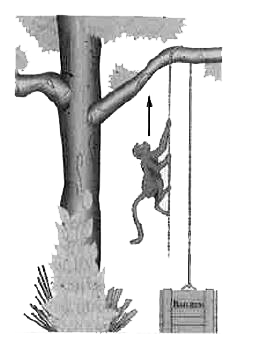A constant horizontal force pushes a 2.00 kg package across a frictionless floor on which an xy coordinate system has been drawn. Figure 5-42 gives the package's x and y velocity components versus time t. What are the (a) magnitude and (b) direction of ?

(a) (b)
Topper's Solved these Questions
- BOOK - RESNICK AND HALLIDAYCHAPTER - FORCE AND MOTION - I EXERCISE - PRACTICE QUESTIONS (Single Correct Choice Type)36videos
FORCE AND MOTION - I
- BOOK - RESNICK AND HALLIDAYCHAPTER - FORCE AND MOTION - I EXERCISE - PRACTICE QUESTIONS (More than One Correct Choice Type)5videos
FORCE AND MOTION - I
- BOOK - RESNICK AND HALLIDAYCHAPTER - FORCE AND MOTION - I EXERCISE - CHECKPOINT5videos
FORCE AND MOTION - I
- BOOK - RESNICK AND HALLIDAYCHAPTER - FLUIDSEXERCISE - PRACTICE QUESTIONS (Integer Type )5videos
FLUIDS
- BOOK - RESNICK AND HALLIDAYCHAPTER - FORCE AND MOTION-IIEXERCISE - PRACTICE QUESTIONS (Integer Type)1videos
FORCE AND MOTION-II
Similar Questions
Two horizontal forces →F1 and →F2 act on a 4.0 kg disk that slides over frictionless ice, on which an xy coordinate system over frictionless ice, on which an xy coordinate system is laid out. Force →F1 is in the positive direction of the x axis and has a magnitude of 7.0 N. Force →F2 has a magnitude of 9.0 N. Figure 5-39 gives the x component vx of the velocity of the disk as a function of time t during the sliding. What is the angle between the constant directions of forces →F1 and →F2 ?
 View Solution
View SolutionIn Fig. 5-54a, a constant horizontal force →Fa is applied to block A, which pushes against block B with a 15.0 N force directed horizontally to the right. In Fig. 5-54b, the same force →Fa is applied to block B, now block A pushes on block B with a 10.0 N force directed horizontally to the left. The blocks have a combined mass of 12.0 kg. What are the magnitudes of (a) their acceleration in Fig. 5-54a and (b) force →Fa ?
 View Solution
View Solution
Knowledge Check
- Question 1 - Select One
A particle moves in the x-y plane under the action of a force →F such that the components of its linear momentum →P at any time t are px=costandpy=3sint. What is the magnitude of the vector →F?
A2√2B5C3D4
In Fig. 5-26a, a constant horizontal force →Fapp of magnitude 20 N is applied to block A of mass mA=4.0 kg, which pushes against block B of mass mB=6.0 kg. The blocks slide over a frictionless surface, along an x axis.
(a) What is the acceleration of the blocks ?
Serious Error: Because force Fapp is applied directly to block A, we use Newton's second law to relate that force to the acceleration →a of block A. because the motion is along the x axis, we use that law for x components (Fnet, x=max), writing it as
Fapp=mAα.
However, this is seriously wrong because →Fapp is not the only horizontal force acting on block A. There is also the force →FAD from block B (Fig. 5-26b).
Dead-End Solution: Let us now include force →FAB by writing, again for the x axis,
Fapp−FAB=mAα.

Figure 5-26 (a) A constant horizontal force →Fapp is applied to block A, which pushes against block B. (b) Two horizontal forces act on block A. (c) Only one horizontal force acts on block B.
(We use the minus sign to include the direction of →FAB.) Because FAB is a second unkon, we cannot solve this equation for a.
Successful Solution: Because of the direction in which force →Fapp is applied, the two blocks form a rigidly connected system. We can relate the net force on the system to the acceleration of the system with Newton's second law. Here, once again for the x axis, we can write that law as
Fapp=(mA+mB)α,
where now we properly apply →Fapp to the system with total mass mA+mB. Solving for a and substituting known values, we find
a=FappmA+mB=20 N)4.0 kg+6.0 kg)=2.0 m/s2.
Thus, the acceleration of the system and of each block is in the positive direction of the x axis and has the magnitude 2.0 m/s2.
(b) What is the (horizontal) force →FBA on block B from block A (Fig. 5-26c) ?View SolutionThe figure here shows two horizontal forces acting on a block on a frictionless floor. If a third horizontal force →F3 also acts on the block, what are the magnitude and direction of →F3 when the block is (a) stationary and (b) moving to the left with a constant speed of 5 m/s ?
 View Solution
View SolutionHere is an example of where you must dig information out of a graph, not just read off a number. In Fig. 5-24a, two forces are applied to a 4.00 kg block on a frictionless floor, but only force →F1 is indicated. That force has a fixed magnitude but can be applied at an adjustable angle θ to the positive direction of the x axis. Force F2 is horizontal and fixed in both magnitude and angle. Figure 5-24b gives the horizontal acceleration ax of the block for any given value of θ from 0∘ to 90∘. What is the value of ax for θ=180∘ ?
View SolutionA 10 kg monkey climbs up a massless rope that runs over a frictionless tree limb and back down to a 15 kg package on the ground (Fig. 5-56). (a) What is the magnitude of the least acceleration the monkey must have if it is to lift the package off the ground? If, after the package has been lifted, the monkey stops its climb and holds on to the rope, what are the (b) magnitude and (c) direction of the monkey's acceleratiohn and (d) the tension in the rope ?
 View Solution
View SolutionA coin slides over a frictionless plane and across an xy coordinate system from the origin to a point with xy coordinates ( 3.0 m , 4.0 m) while a constant force acts on it. The force has magnitude 2.5 N and is directed at a counter-clockwise angle of 100∘ from the positive direction of the x axis. How much work is done by the force on the coin during the displacement ?
View SolutionA particle of m=5kg is momentarily at rest at x=att=. It is acted upon by two forces →F1 and →F2. Vec(F)1=70ˆj N. The direction and manitude of →F2 are unknown. The particle experiences a constant acceleration, →a,in the direction as shown in (figure) Neglect gravity.

a.Find the missing force →F2.
b. What is the velocity vector of the particle at t=10s?
c. What third force, →F3 is required to make the acceleration of the particle zero? Either give magnitude and direction of →F3 or its components.View SolutionA particle of m=5kg is momentarily at rest at x=att=. It is acted upon by two forces →F1 and →F2. Vec(F)1=70ˆj N. The direction and manitude of →F2 are unknown. The particle experiences a constant acceleration, →a,in the direction as shown in (figure) Neglect gravity.

a.Find the missing force →F2.
b. What is the velocity vector of the particle at t=10s?
c. What third force, →F3 is required to make the acceleration of the particle zero? Either give magnitude and direction of →F3 or its components.View Solution

